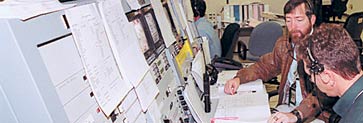
By Kimberly R. Jenkins
As the new team lead, I came in from outside the group. Rather than just assuming that I knew what was needed, I decided to ask them. Who should know better, right?
To me, leading a team meant providing them with what they needed. I didn’t want to come into the group demanding this is what we’re going to do and this is how we’re going to do it. I wanted them to know that I was really interested in what they thought needed to be done.
I was fortunate to have had a lead that used this approach. She led by serving her team, and I admired her for that. I remember thinking: This is somebody I can enjoy working for. As I worked my way up to being a lead, I recalled the good qualities of the managers who I respected. I tried to develop my own style around what I learned from them.
We were a team of five engineers responsible for the command and data systems used during experiment integration and testing of Spacelab payloads. For the most part, we performed component level testing for the experiments, the first phase of testing for Spacelab Program payloads. In the beginning, the members of my team didn’t know what to think of me, but as time went by they realized that I was sincere. A relationship based on trust developed.
I made several observations as we worked together more, but the most obvious one to me was the simple fact that no attention had been paid to the control room where we worked.The systems we used at that time were large mainframe computers with magnetic tape devices, which made the control room very noisy and did nothing for the decor. I’m talking ancient looking. Picture this: bare walls, drab paint, and not one shuttle or payload photo in sight.
I know I may be making a big deal out of this, but when you’re sitting at a console all day supporting a test, your environment does start to weigh on your mind.We worked twelve-hour days for weeks at a time. The only time we took a break was to go to the bathroom or grab lunch or a snack. Those were long grueling days for all of us. We were shut away in a depressing room, and no one had done anything to improve it.
I’m not sure why things were this way. Perhaps, the engineers on my team were simply oblivious to the appearance of their surroundings. They worked quite well together, and they didn’t have any problems among themselves. But it became obvious to me that they were “out of sight, out of mind.” The group was overshadowed by another group of engineers who seemed to get more of management’s attention. I don’t think this was done intentionally; it just happened.
I also learned of other difficulties they’d had before I joined them. The previous lead was also a female, and apparently she felt it necessary to project a tough exterior. It didn’t sound as though she had ever expressed her appreciation for the work they had done, so when I came in I think that they were skeptical. To their credit, when I brought up the idea of improving the look of the control room, everyone immediately pitched in by sharing ideas about what we could do. Before you knew it, the remodeling had begun.
We had a door installed to separate the mainframe computers from the consoles. When we sat at the consoles, the room was now quiet. We had carpet put down which also helped suppress the noise. It was much easier for us to communicate with each other and with the rest of the test team. We had the walls covered with gray and blue carpet paneling. We had graphics create commemoratives of each mission, and we hung them on the walls. The guys teased me because I posted inspirational sayings around the room, as well, and I gave them buttons that said, “You’re the best!” or “You did a great job today!” I know this may sound corny, but those little things, done with sincerity, showed them that I cared about them and wanted to make our environment a better place for us to work.
We started using the control room as our office and often brought work there to complete. We supported several missions at a time so while things were running smoothly with the systems during one test, we could review procedures or documents in preparation for upcoming tests. The control room became our home away from home.
Since then, we’ve all moved on to other projects, but every now and then we run into each other and the bond that we have is still strong. This experience reminds me that we often overlook the simple things. Every good manager wants to do well by the people working on a project. One way to achieve this is simple: Pay attention to the environment in which your employees work. People warn you not to get mired in the details; they say you might miss the big picture. But sometimes it’s the details that give you a better view of what the big picture is all about.
Lessons
- Leaders lead by serving their people.
- Encourage people to define and create their own workspace. Small details are important.
Question
Can you think of a time when something in your workspace prevented you from doing your best work? A time when a change to your environment made things easier?
Search by lesson to find more on:
- Leadership
- Work Environment






